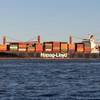Bataan Departs Norfolk Naval Shipyard, Returns to Sea
By Mass Communication Specialist 2nd Class (SW/AW) Pedro A. Rodríguez, USS Bataan Public Affairs
USS Bataan (LHD 5) left the Norfolk Naval Shipyard after an eight month dry-docked planned maintenance availability (DPMA), May 5.
Some major jobs completed aboard were completion of a seawater compensated fuel system modification and upgrades to support the newest vertical/short take off and landing Marine Corps aircraft, the MV-22 Osprey.
The fuel compensation modification changes the way the fuel tanks aboard the ship are emptied. As fuel is used, the emptying tanks fill with seawater, so the ship's stability is not reduced as fuel is burned while underway.
"The biggest thing with this modification is stability, but it also requires less manpower to operate, and to some extent, reduces the risk of fuel spills," said Chief Machinist's Mate (SW) Donald Woodard.
The upgrades for the MV-22 Osprey aircraft were made in the hangar bay, flight deck, Aircraft Intermediate Maintenance Department, and supply aviation storage spaces.
"We got a new avionics work center and two metal bending shops specifically for the MV-22," said Chief Aviation Electrician's Mate (AW/SW) Chad A. Vance. "We can now meet the operational requirements of the aircraft."
During the DPMA, many members of 's crew worked on other needed repairs. The paint team, directed by Chief Aviation Boatswain's Mate (Handling) (AW/SW) Hector M. Arroyo, expended thousands of man hours to paint more than 250 spaces, saving thousands of dollars.
"We had two shifts; the main job of the day shift was to prepare the spaces for the night shift, who came in at night to get the spaces painted," said Arroyo.
Other jobs aboard included repairs to the crew living spaces, enhancing the quality of life for crew members who live aboard the ship. Crew members fixed more than 2,000 racks in 17 living spaces throughout the ship.
"We prepared all living spaces so the paint team could save time painting the spaces," said Aviation Ordnanceman 3rd Class Alexander N. Pisanello, assigned to the rehab team. "We also installed toilets, shower heads, sinks and mirrors."
The main machinery rooms also received repairs and upgrades. had four fuel oil manifolds removed; many fuel tanks were combined into four groups and are now compensated with sea water.
"There were hundreds of feet of new piping installed, and old-style tank level indicators were removed and replaced with radar indicators," said Woodard.
During the eight months the ship was in the yards, 's Sailors never lost ownership of their ship. The Sailors stood duty aboard, manning some of the critical spaces, which required a lot of flexibility.
During the DPMA final phase, conducted her light off assessment, which ensures engineers can safely light off and steam the plant. The events conducted include a management program review to ensure the ship is in accordance with all governing documents and a safety walk-through is done to make sure the material readiness of the main spaces can support the safe light-off.
"The preparations started the day we entered the shipyard," said Woodard. "We had to clean, paint and preserve the engineering spaces."
All equipment is checked using the preventive maintenance system or master light off checks.
"All checks are followed up by a main space fire drill to ensure the ship's fire party can properly fight a main space fire," said Woodard.
"It was eight months of hard work," said Capt. Rick Snyder, 's commanding officer. "We were faced with a lot of challenges in different areas, and we are ready to get back to sea and our nation's tasking."












